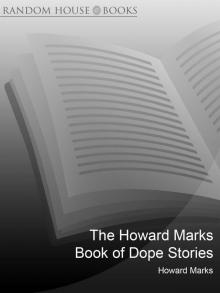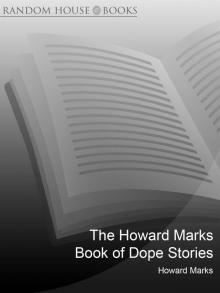- Home
- Howard Marks
The Most Important Thing Illuminated
The Most Important Thing Illuminated Read online
THE MOST IMPORTANT THING ILLUMINATED
Columbia University Press
Publishers Since 1893
New York Chichester, West Sussex
cup.columbia.edu
Copyright © 2013 Howard Marks
All rights reserved
E-ISBN 978-0-231-53079-8
The original impression of this e-book was produced with http://pressbooks.com.
Library of Congress Cataloging-in-Publication Data
Marks, Howard, 1946-
The most important thing illuminated : uncommon sense for the thoughtful investor / Howard Marks.
p. cm.
Includes bibliographical references.
ISBN 978–0-231–16284–5 (cloth : alk. paper)—ISBN 978–0-231–53079–8 (e-book)
1. Investments. 2. Portfolio management. 3. Investment analysis. 4. Risk management. I. Title.
HG4521.M3215 2012
332.6—dc23
2012003076
A Columbia University Press E-book.
CUP would be pleased to hear about your reading experience with this e-book at [email protected].
References to Internet Web sites (URLs) were accurate at the time of writing. Neither the author nor Columbia University Press is responsible for URLs that may have expired or changed since the manuscript was prepared.
For Nancy, Jane, and Andrew With All My Love
Contents
Foreword by Bruce C. Greenwald
Introduction
THE MOST IMPORTANT THING IS …
1 Second-Level Thinking
2 Understanding Market Efficiency (and Its Limitations)
3 Value
4 The Relationship Between Price and Value
5 Understanding Risk
6 Recognizing Risk
7 Controlling Risk
8 Being Attentive to Cycles
9 Awareness of the Pendulum
10 Combating Negative Influences
11 Contrarianism
12 Finding Bargains
13 Patient Opportunism
14 Knowing What You Don’t Know
15 Having a Sense for Where We Stand
16 Appreciating the Role of Luck
17 Investing Defensively
18 Avoiding Pitfalls
19 Adding Value
20 Reasonable Expectations
21 Pulling It All Together
About the Contributors
Foreword
For twenty years Howard Marks has been educating investors with his “Memos from the Chairman,” and in writing The Most Important Thing, Marks drew from these memos to compile the most important lessons he has learned as an investor. That he is an outstanding investor goes without saying; he is also a great teacher and a thoughtful author, and The Most Important Thing is a generous gift to all investors.
In The Most Important Thing Illuminated, readers will benefit not only from Marks’s hard-earned wisdom, but also from the insights of three seasoned investors—Christopher Davis, Joel Greenblatt, and Seth Klarman—and a Columbia Business School adjunct professor, Paul Johnson. Each annotator in this impressive group brings a unique perspective to Marks’s work, and an investment style that colors their reaction to Marks’s text. For Davis, superior investment ability seems to be innate, and his success is amplified by his commitment to a value approach and his disciplined industry focus. Greenblatt—himself the author of the bestselling investment book The Little Book That Beats the Market—has gained tremendous success through his keen eye for irrational institutional behavior. His initial insight into corporate spin-offs has been followed up by his more recent focus on overall market anomalies. Klarman has produced almost three decades of extraordinary results while being aggressively risk adverse—and his performance is even more remarkable when one learns of his near obsession with down-side protection. Finally, Johnson brings his almost thirty years as an investment professional and twenty years as an adjunct professor to reveal how he has begun to incorporate Marks’s wisdom into his courses on security analysis and value investing.
Their annotations on the original text add depth and dimension to Marks’s argument, as these four thinkers discuss how Marks’s philosophy resonates with, refines, or occasionally differs from their own. Marks even adds his own commentary throughout the text, bringing to light some of the underlying themes that run through the book and articulating the top priorities among his recommended actions. In addition, he offers one extra lesson not covered in the original book, on the importance of reasonable expectations. I like to think of The Most Important Thing Illuminated as a surrogate book group with five of the best investment thinkers alive.
Most important, this new project joins The Most Important Thing as an invaluable contribution to the value investing canon. Value investing began at Columbia with the publication of Benjamin Graham and David Dodd’s Security Analysis in 1936. In 2001, the Heilbrunn Center for Graham and Dodd Investing was established at Columbia Business School It has since emerged as the academic home of value investing.
I find it fitting and gratifying that the center played a role in the book’s formation. The Most Important Thing was initially conceived at CSIMA (the Columbia Student Investment Management Association), Heilbrunn’s annual investment conference. After hearing Marks give a presentation at the conference, Myles Thompson, founder of Columbia Business School Publishing, approached him about doing a book based on his memos and his investment philosophy. Marks was enthusiastic about publishing his investment wisdom at the birthplace of value investing and knew his ideas would be embraced by the Heilbrunn community. The Most Important Thing was launched a year later at the same event; The Most Important Thing Illuminated launched at the 2012 CSIMA meeting.
The Most Important Thing Illuminated continues the value investing community’s tradition of generously sharing its ideas, insights, and investment wisdom. The Heilbrunn Center is delighted to be associated with this innovative publication and truly illuminating new contribution.
BRUCE C. GREENWALD
Director, Heilbrunn Center for Graham and Dodd Investing
Robert Heilbrunn Professor of Finance and Asset Management
Introduction
For the last twenty years I’ve been writing occasional memos to my clients—first at Trust Company of the West and then at Oaktree Capital Management, the company I cofounded in 1995. I use the memos to set forth my investment philosophy, explain the workings of finance and provide my take on recent events. Those memos form the core of this book, and you will find passages from many of them in the pages that follow, for I believe their lessons apply as well today as they did when they were written. For inclusion here I’ve made some minor changes, primarily to make their message clearer.
PAUL JOHNSON: I never had a single text to use in teaching my investment courses at the Columbia Graduate School of Business until I read Howard Marks’s The Most Important Thing. I used his book in the fall of 2011 as the primary text in my course on value investing and security analysis. Marks’s discussion was an excellent complement to my lectures.
What, exactly, is “the most important thing”? In July 2003, I wrote a memo with that title that pulled together the elements I felt were essential for investment success. Here’s how it began: “As I meet with clients and prospects, I repeatedly hear myself say, ‘The most important thing is X.’ And then ten minutes later it’s, ‘The most important thing is Y.’ And then Z, and so on.” All told, the memo ended up discussing eighteen “most important things.”
Since that original memo, I’ve made a few adjustments in the things I consider “the most important,” but the fundamental notion is unchanged: t
hey’re all important. Successful investing requires thoughtful attention to many separate aspects, all at the same time. Omit any one and the result is likely to be less than satisfactory. That is why I have built this book around the idea of the most important things—each is a brick in what I hope will be a solid wall, and none is dispensable.
PAUL JOHNSON: This comment is a theme that runs through The Most Important Thing and is critical to Marks’s view of investing. I believe the most challenging investment concept to explain to graduate business students is that investing requires the concurrent balancing of many different fundamental issues. The Most Important Thing does an excellent job of making this point clear.
I didn’t set out to write a manual for investing. Rather, this book is a statement of my investment philosophy. I consider it my creed, and in the course of my investing career it has served like a religion. These are the things I believe in, the guideposts that keep me on track. The messages I deliver are the ones I consider the most lasting. I’m confident their relevance will extend beyond today.
HOWARD MARKS: This book is primarily about what I call “the human side of investing.” It does not offer much on financial analysis or investment theory—more how to think and how to deal with the psychological influences that interfere with investment thinking and a lot about the mistakes others make in their thinking. When I say “how to think,” I don’t mean to suggest that my process is the only way, just one example. You have to follow a disciplined thought process in order to be successful, but it doesn’t have to be mine.
You won’t find a how-to book here. There’s no surefire recipe for investment success. No step-by-step instructions. No valuation formulas containing mathematical constants or fixed ratios—in fact, very few numbers. Just a way to think that might help you make good decisions and, perhaps more important, avoid the pitfalls that ensnare so many.
It’s not my goal to simplify the act of investing. In fact, the thing I most want to make clear is just how complex it is. Those who try to simplify investing do their audience a great disservice. I’m going to stick to general thoughts on return, risk and process; any time I discuss specific asset classes and tactics, I do so only to illustrate my points.
A word about the organization of the book. I mentioned above that successful investing involves thoughtful attention to many areas simultaneously. If it were somehow possible to do so, I would discuss all of them at once. But unfortunately the limitations of language force me to take one topic at a time. Thus I begin with a discussion of the market environment in which investing takes place, to establish the playing field. Then I go on to discuss investors themselves, the elements that affect their investment success or lack of it, and the things they should do to improve their chances. The final chapters are an attempt to pull together both groups of ideas into a summation. Because my philosophy is “of a piece,” however, some ideas are relevant to more than one chapter; please bear with me if you sense repetition.
I hope you’ll find this book’s contents novel, thought provoking and perhaps even controversial. If anyone tells me, “I so enjoyed your book; it bore out everything I’ve ever read,” I’ll feel I failed. It’s my goal to share ideas and ways of thinking about investment matters that you haven’t come across before. Heaven for me would be seven little words: “I never thought of it that way.”
In particular, you’ll find I spend more time discussing risk and how to limit it than how to achieve investment returns. To me, risk is the most interesting, challenging and essential aspect of investing.
PAUL JOHNSON: The Most Important Thing is the first comprehensive discussion of risk and its importance in the investment process that I have read. In fact, the strongest aspect of the book and its greatest contribution to the canon of investment wisdom is its extensive discussion of risk.
When potential clients want to understand what makes Oaktree tick, their number one question is usually some variation on “What have been the keys to your success?” My answer is simple: an effective investment philosophy, developed and honed over more than four decades and implemented conscientiously by highly skilled individuals who share culture and values.
Where does an investment philosophy come from? The one thing I’m sure of is that no one arrives on the doorstep of an investment career with his or her philosophy fully formed. A philosophy has to be the sum of many ideas accumulated over a long period of time from a variety of sources. One cannot develop an effective philosophy without having been exposed to life’s lessons. In my life I’ve been quite fortunate in terms of both rich experiences and powerful lessons.
The time I spent at two great business schools provided a very effective and provocative combination: nuts-and-bolts and qualitative instruction in the pre-theory days of my undergraduate education at Wharton, and a theoretical, quantitative education at the Graduate School of Business of the University of Chicago. It’s not the specific facts or processes I learned that mattered most, but being exposed to the two main schools of investment thought and having to ponder how to reconcile and synthesize them into my own approach.
Importantly, a philosophy like mine comes from going through life with your eyes open. You must be aware of what’s taking place in the world and of what results those events lead to. Only in this way can you put the lessons to work when similar circumstances materialize again. Failing to do this—more than anything else—is what dooms most investors to being victimized repeatedly by cycles of boom and bust.
SETH KLARMAN: Keeping your eyes open also increases the probability that you will be prepared for something that has never before occurred. Warren Buffett stressed the importance of this during his search for a successor. Alertness can help to identify and possibly avoid growing risks before it is too late. Marks makes this point in chapter 5.
I like to say, “Experience is what you got when you didn’t get what you wanted.”
JOEL GREENBLATT: This is one of my favorite “Howardisms.” I have the opportunity to think of it often!
Good times teach only bad lessons: that investing is easy, that you know its secrets, and that you needn’t worry about risk. The most valuable lessons are learned in tough times. In that sense, I’ve been “fortunate” to have lived through some doozies: the Arab oil embargo, stagflation, Nifty Fifty stock collapse and “death of equities” of the 1970s; Black Monday in 1987, when the Dow Jones Industrial Index lost 22.6 percent of its value in one day; the 1994 spike in interest rates that put rate-sensitive debt instruments into freefall; the emerging market crisis, Russian default and meltdown of Long-Term Capital Management in 1998; the bursting of the tech-stock bubble in 2000–2001; the accounting scandals of 2001–2002; and the worldwide financial crisis of 2007–2008.
Living through the 1970s was particularly formative, since so many challenges arose. It was virtually impossible to get an investment job during the seventies, meaning that in order to have experienced that decade, you had to have gotten your job before it started. How many of the people who started by the sixties were still working in the late nineties when the tech bubble rolled around? Not many. Most professional investors had joined the industry in the eighties or nineties and didn’t know a market decline could exceed 5 percent, the greatest drop seen between 1982 and 1999.
SETH KLARMAN: This fact may be one of the most shocking statements in this book. During this period, investors were lulled to sleep, anticipating double-digit annual returns while completely losing sight of the risks. Seventeen years ought to qualify as long term—it is roughly half of a career—yet a career built only during this period would hardly have withstood the test of time.
If you read widely, you can learn from people whose ideas merit publishing. Some of the most important for me were Charley Ellis’s great article “The Loser’s Game” (The Financial Analysts Journal, July-August 1975), A Short History of Financial Euphoria, by John Kenneth Galbraith (New York: Viking, 1990) and Nassim Nicholas Taleb’s Fooled by Randomness (New York: Te
xere, 2001). Each did a great deal to shape my thinking.
PAUL JOHNSON: This is an excellent book list. Fortunately, students can now add The Most Important Thing to it!
Finally, I’ve been extremely fortunate to learn directly from some outstanding thinkers: John Kenneth Galbraith on human foibles; Warren Buffett on patience and contrarianism; Charlie Munger on the importance of reasonable expectations; Bruce Newberg on “probability and outcome”; Michael Milken on conscious risk bearing; and Ric Kayne on setting “traps” (underrated investment opportunities where you can make a lot but can’t lose a lot). I’ve also benefited from my association with Peter Bernstein, Seth Klarman, Jack Bogle, Jacob Rothschild, Jeremy Grantham, Joel Greenblatt, Tony Pace, Orin Kramer, Jim Grant and Doug Kass.
The happy truth is that I was exposed to all of these elements and aware enough to combine them into the investment philosophy that has worked for my organizations—and thus for my clients—for many years. It’s not the only right one—there are lots of ways to skin the cat—but it’s right for us.
I hasten to point out that my philosophy wouldn’t have meant much without skilled implementation on the part of my incredible Oaktree cofounders—Bruce Karsh, Sheldon Stone, Larry Keele, Richard Masson and Steve Kaplan—with whom I was fortunate to team up between 1983 and 1993. I’m convinced that no idea can be any better than the action taken on it, and that’s especially true in the world of investing. The philosophy I share here wouldn’t have attracted attention were it not for the accomplishments of these partners and the rest of my Oaktree colleagues.
Howard Marks: Through these annotations I want to recognize the wonderful people who contributed to the making of this book: Bridget Flannery-McCoy, Milenda Lee, Jennifer Jerome, Meredith Howard, and Noah Arlow of Columbia University Press, as well as my editorial consultant, Maggie Stuckey. Above all, I want to thank Myles Thompson for coming to me with the idea of doing a book with Columbia and guiding it to fruition. Finally, I want to add mention of my friend Peter Kaufman, who has contributed to my thinking by suggesting noninvestment parallels.

 Mr Nice
Mr Nice The Howard Marks Book of Dope Stories
The Howard Marks Book of Dope Stories Senor Nice: Straight Life From Wales to South America
Senor Nice: Straight Life From Wales to South America The Score
The Score Sympathy for the Devil
Sympathy for the Devil The Most Important Thing Illuminated
The Most Important Thing Illuminated Senor Nice
Senor Nice Howard Marks' Book of Dope Stories
Howard Marks' Book of Dope Stories